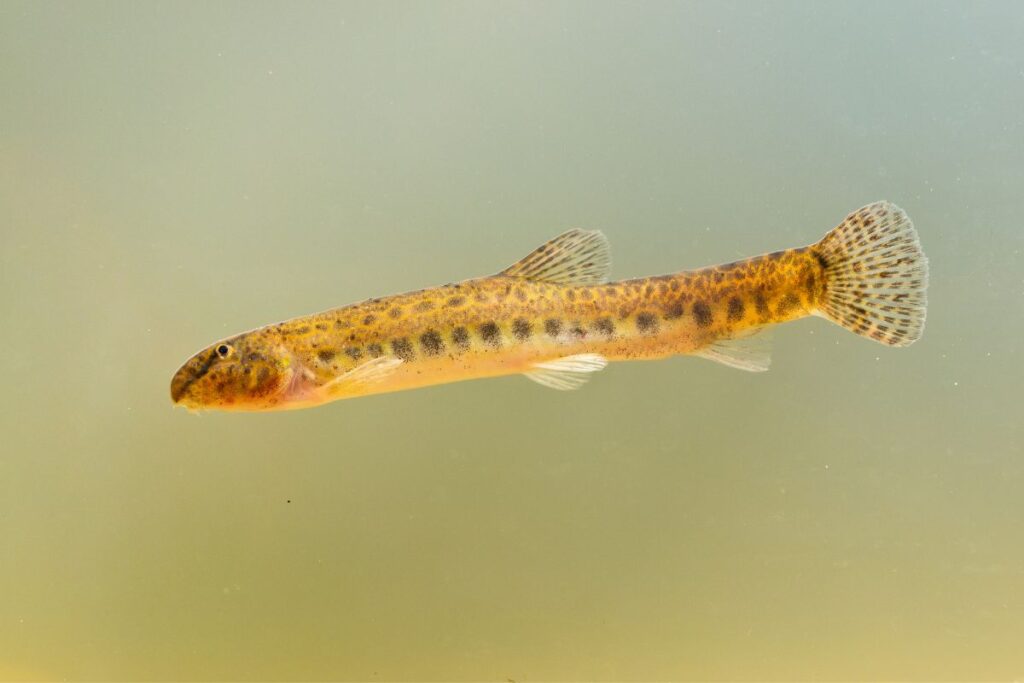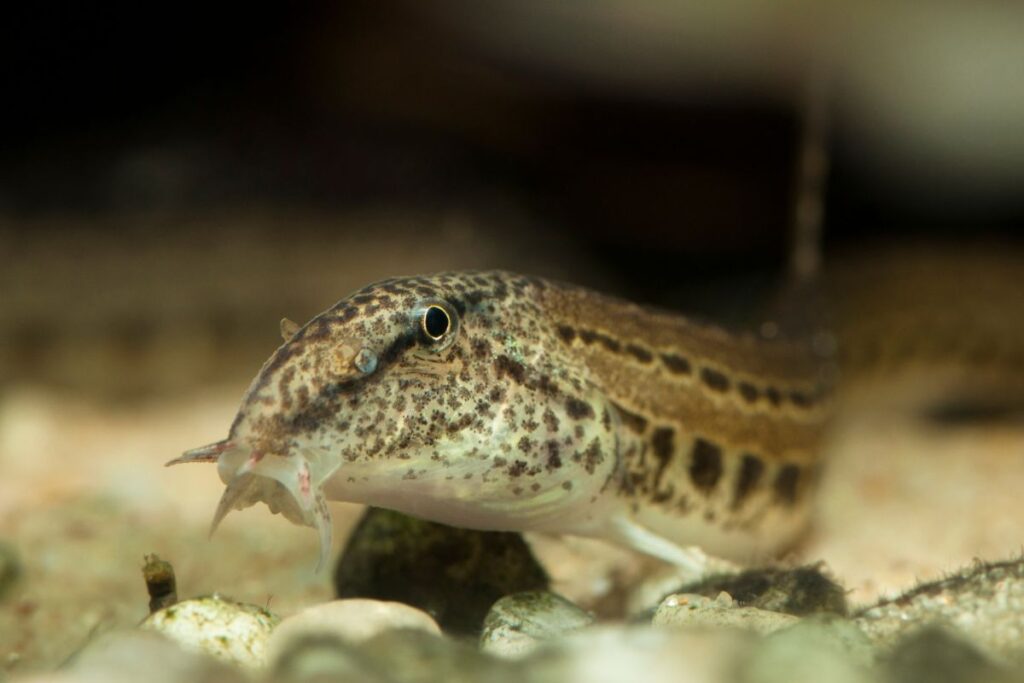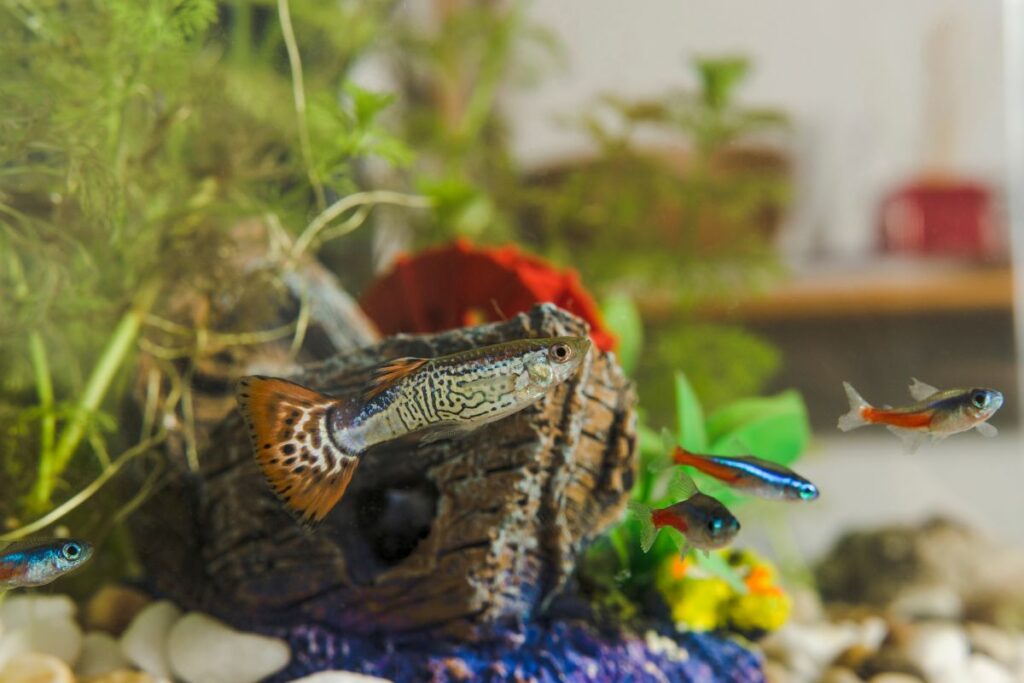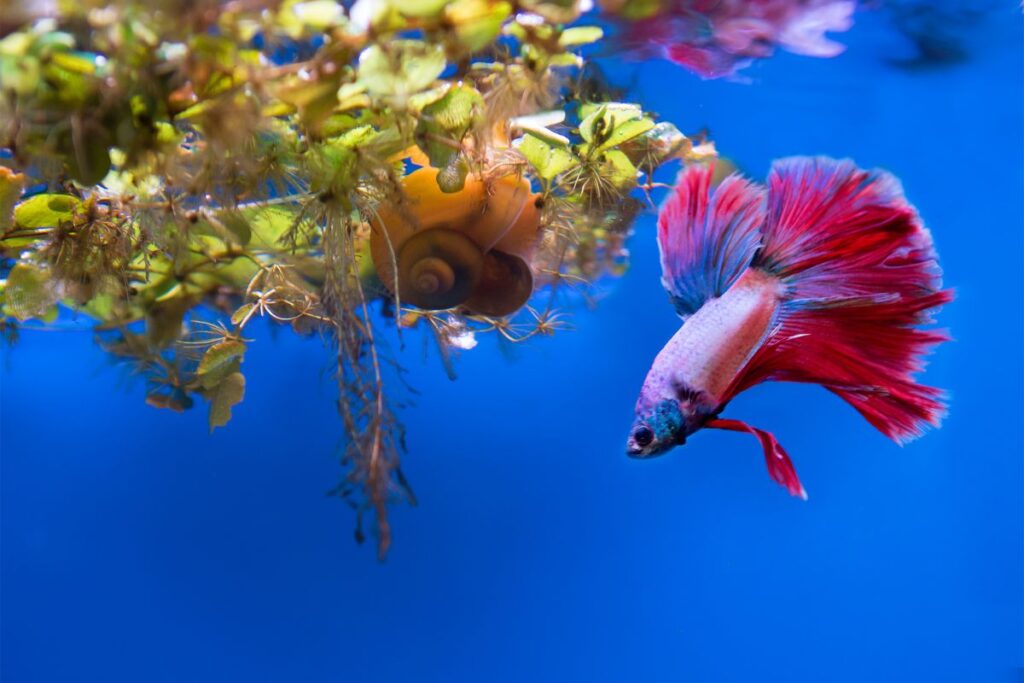If you’re looking for an interesting and unique addition to your aquarium, the dwarf chain loach might just be the perfect choice for you. These small, colorful fish are native to Southeast Asia and are known for their playful personalities and active swimming habits. However, before you bring home a dwarf chain loach, it’s important to understand their specific care requirements.
Dwarf Chain Loach is a freshwater fish species that requires a minimum tank size of 10 gallons. They prefer a pH range of 6.5-7.5 and moderate water flow. They are omnivorous and should be fed a varied diet of flakes, pellets, and live/frozen foods. Regular water changes and proper filtration are necessary for their well-being.
One of the most important things to keep in mind when caring for dwarf chain loaches is their need for a well-maintained aquarium environment. These fish require clean, well-oxygenated water with a pH between 6.5 and 7.5. They also prefer a planted tank with plenty of hiding places, such as caves or driftwood. Additionally, it’s important to avoid keeping dwarf chain loaches with aggressive or territorial fish, as they can become stressed and even injured in such an environment.
Another key aspect of dwarf chain loach care is their diet. These fish are omnivores, meaning they require a varied diet that includes both plant and animal matter. You can feed them a combination of high-quality flakes, pellets, and frozen or live foods such as brine shrimp, bloodworms, and daphnia. It’s important to avoid overfeeding, however, as this can lead to health problems such as obesity and digestive issues.

Table of Contents
Species Summary
If you’re considering adding a Dwarf Chain Loach to your aquarium, it’s important to understand their basic characteristics. Here’s what you need to know:
Origin
The Dwarf Chain Loach is native to Southeast Asia, specifically in the Mekong River basin. They can also be found in other parts of the region, including Thailand, Cambodia, and Laos.
Lifespan
Dwarf Chain Loaches have a lifespan of around 5 years, but with proper care, they can live longer.
Appearance
These loaches have a unique appearance, with a long and slender body that’s covered in a series of chain-like markings.
They have a dark brown or black coloration, with a lighter underbelly. Their fins are transparent and delicate, and they have a small, pointed head.
Size
Dwarf Chain Loaches are small fish, growing to a maximum size of around 3 inches.
Growth Rate
The growth rate of Dwarf Chain Loaches is relatively slow, but with a healthy diet and optimal living conditions, they can grow steadily over time.
Behavior & Temperament
Dwarf Chain Loaches are active and social fish, often seen swimming in groups. They are peaceful and non-aggressive, making them an excellent addition to a community aquarium.
They are also known for their playful and curious nature, often exploring their surroundings and interacting with other fish.
Male vs Female
Distinguishing between male and female Dwarf Chain Loaches can be challenging, as they look very similar.
However, females tend to be slightly larger and plumper than males, especially during breeding season.
Personally, I’ve found Dwarf Chain Loaches to be fascinating and entertaining fish to keep in my own aquarium. Their playful behavior and unique appearance make them a standout addition to any tank. Just be sure to provide them with a healthy, well-balanced diet and a clean, well-maintained living environment to ensure they thrive.
Tank Setup
Setting up the perfect tank for your Dwarf Chain Loach is crucial to their health and well-being. Here are some things to consider when setting up your tank:
Tank Size
The ideal tank size for Dwarf Chain Loaches is at least 20 gallons. This will give them plenty of room to swim and explore. Keep in mind that these fish are social creatures, so it’s best to keep them in groups of six or more.
Lighting
When it comes to lighting, Dwarf Chain Loaches prefer a dimly lit tank. This can be achieved with low wattage bulbs or by using floating plants to provide shade.
Filtration & Aeration
Good filtration and aeration are essential for the health of your Dwarf Chain Loaches. A hang-on-back filter or a canister filter is recommended.
You should also consider adding an air stone or bubbler to provide additional oxygenation.
Heater
Dwarf Chain Loaches prefer a water temperature between 72-78°F. A reliable aquarium heater is necessary to maintain a consistent temperature.
Substrate
A fine sand substrate is ideal for Dwarf Chain Loaches as they like to burrow. Avoid using sharp or rough substrates that could damage their delicate barbels.
Decoration
Provide plenty of hiding places for your Dwarf Chain Loaches. Rocks, driftwood, and caves are all great options. It’s important to avoid sharp edges or small openings that could trap or injure your fish.
Plants
Live plants are a great addition to any tank and can provide hiding places and grazing areas for your Dwarf Chain Loaches.
Java ferns, anubias, and mosses are all good choices as they don’t require high lighting or CO2 injection.
When setting up your Dwarf Chain Loach tank, keep in mind that they are active and social fish that love to explore. With the right setup, you can provide them with a happy and healthy home.
Personally, I have found that my Dwarf Chain Loaches are happiest when they have plenty of plants to hide in and explore.
They also love to play in the current created by my filter, so I make sure to provide plenty of flow in their tank.
Water Quality
When it comes to taking care of dwarf chain loaches, maintaining the right water quality is crucial. Here are some key factors to keep in mind:
Water Temperature
The ideal water temperature for dwarf chain loaches is between 75°F and 82°F. Keep your tank’s temperature consistent to avoid stressing your fish.
I have found that using a reliable aquarium heater is the easiest way to maintain a stable temperature.
Water pH
Dwarf chain loaches prefer a slightly acidic pH level between 6.0 and 7.0. However, they can tolerate a range of pH levels as long as they remain stable.
To keep your loaches healthy, test your water regularly and adjust the pH level as needed.
Water Hardness
These fish prefer soft to moderately hard water with a dGH of 5-12. If your water is too hard, you can use a water softening agent or consider adding driftwood to your tank.
On the other hand, if your water is too soft, you can add crushed coral or limestone to increase the hardness.
Water Changes
Regular water changes are essential for maintaining good water quality. Aim to change 25% of your tank’s water every week.
This will help keep the water parameters stable and remove any excess nutrients or waste products. I personally like to use a siphon to remove the water and a bucket to refill it.
By keeping an eye on these key factors, you can help ensure that your dwarf chain loaches thrive in their environment. Remember to test your water regularly and make adjustments as needed to keep your fish healthy and happy.
Tank Maintenance
Maintaining a clean and healthy tank is crucial to the well-being of your dwarf chain loaches. Here are a few tips to keep your tank in top shape:
First, perform regular water changes to keep the water clean and clear. You should aim to change 20-30% of the water every week.
Use a siphon to remove any debris and uneaten food from the substrate.
Next, check the water parameters regularly using a test kit. Dwarf chain loaches prefer slightly acidic water with a pH between 6.5 and 7.5.
The temperature should be kept between 75-82°F. If the parameters are not within the appropriate range, make adjustments as necessary.
It’s also important to clean the filter regularly. A dirty filter can lead to poor water quality and harm your fish. Follow the manufacturer’s instructions for cleaning and maintenance.
Finally, keep an eye out for any signs of illness or disease in your fish. If you notice anything unusual, such as lethargy, loss of appetite, or abnormal behavior, take action immediately.

Personally, I have found that keeping a clean and well-maintained tank not only benefits the health of my dwarf chain loaches, but it also makes for a more enjoyable viewing experience. Watching them swim around in crystal clear water is truly a sight to behold!
Tank Mates
If you’re considering adding dwarf chain loaches to your aquarium, it’s important to choose tank mates that will get along with them.
Here are a few things to keep in mind when selecting fish to share a tank with your dwarf chain loaches.
Compatible Fish Species
When it comes to compatible fish species, dwarf chain loaches are relatively easy to match up with other peaceful community fish. Some good options include:
- Tetras
- Danios
- Guppies
- Corydoras catfish

These fish are all peaceful and won’t compete with your dwarf chain loaches for food. They also share similar water temperature and pH requirements, making them ideal tank mates.
Incompatible Fish Species
While dwarf chain loaches are generally peaceful, there are some fish species that don’t mix well with them. Avoid adding any aggressive or territorial fish to the tank, such as:
- Cichlids
- Barbs
- Gouramis
- Bettas

These fish are likely to bully or harm your dwarf chain loaches, which can cause stress and even death.
Do Dwarf Chain Loaches Need Groups?
Dwarf chain loaches are social creatures and should be kept in groups of at least six.
When kept in groups, they will be more active and display natural behaviors, such as schooling and exploring the tank.
If you only have one or two dwarf chain loaches, they may become stressed and hide away.
From my personal experience, I found that my dwarf chain loaches were happiest when they were kept with a group of other peaceful fish. They would often swim together and play, and it was a joy to watch them interact with each other.
Diet
Proper diet is crucial for the health and well-being of your dwarf chain loach. In this section, we’ll cover what to feed, how often to feed, and some tips to keep in mind.
What To Feed
Dwarf chain loaches are omnivores and will eat a variety of foods. They enjoy live or frozen foods such as brine shrimp, bloodworms, and daphnia.
They also eat flakes or pellets, but it’s important to make sure the food sinks to the bottom of the tank where they can find it.
Personally, I’ve found that my dwarf chain loaches love to eat small snails. I used to have a snail problem in my tank until I introduced these loaches. They quickly took care of the snails and now they get a tasty treat every once in a while.
Frequency
Feed your dwarf chain loaches once or twice a day, but be careful not to overfeed.
Overfeeding can lead to health problems and water quality issues. A good rule of thumb is to only feed them what they can eat in a few minutes.
It’s also a good idea to vary their diet. Don’t feed them the same thing every day. Switch it up and offer them a variety of foods to keep them healthy and happy.
Tips
- Make sure the food sinks to the bottom of the tank where the loaches can find it.
- Don’t overfeed. Only feed them what they can eat in a few minutes.
- Vary their diet. Offer them a variety of foods to keep them healthy and happy.
- Consider adding small snails to their diet for a tasty treat.
Common Diseases
Diseases
Dwarf Chain Loaches are generally hardy fish, but they are still susceptible to a few diseases.
The most common diseases that affect them are bacterial and parasitic infections.
These diseases can be caused by poor water quality, stress, overcrowding, or a weakened immune system.
Symptoms
If your Dwarf Chain Loach is sick, there are a few symptoms you should look out for. These include:
- Loss of appetite
- Lethargy
- Difficulty swimming
- Visible wounds or sores
- Abnormal behavior
If you notice any of these symptoms, it is important to take action quickly to prevent the disease from spreading to other fish in your tank.
Treatment
If your Dwarf Chain Loach is sick, there are a few treatments you can try. The first step is to isolate the sick fish in a quarantine tank to prevent the disease from spreading.
You can then try treating the fish with antibiotics, anti-parasitic medication, or other treatments recommended by a veterinarian.
It is important to follow the instructions carefully and monitor the fish closely to ensure that the treatment is effective.
Prevention
Prevention is the best way to keep your Dwarf Chain Loaches healthy. You can do this by:
- Maintaining good water quality
- Feeding your fish a balanced diet
- Providing plenty of hiding places and space to swim
- Quarantining new fish before adding them to your tank
- Keeping your tank clean and well-maintained
By following these tips, you can help prevent diseases from affecting your Dwarf Chain Loaches and keep them healthy and happy.
Personal Anecdote
I once had a Dwarf Chain Loach that developed a bacterial infection. I noticed that it was lethargic and wasn’t eating, so I immediately isolated it in a quarantine tank and treated it with antibiotics. Within a few days, the fish started to show signs of improvement and eventually made a full recovery. Since then, I have been extra careful to maintain good water quality and keep an eye out for any signs of illness in my fish.
Signs of a Healthy Dwarf Chain Loach
When it comes to keeping dwarf chain loaches, it’s important to know what a healthy fish looks like. Here are some signs to watch out for:
- Active and Alert: A healthy dwarf chain loach will be active and alert, swimming around and exploring its environment.
- Good Appetite: A healthy fish will have a good appetite and eagerly eat its food.
- Bright Colors: A healthy dwarf chain loach will have bright, vibrant colors, and its markings will be clear and distinct.
- Clean Gills: Healthy fish have clean, clear gills that are not swollen or discolored.
- No Signs of Disease: A healthy fish will show no signs of disease or infection, such as white spots or red sores on the body.
It’s important to note that some dwarf chain loaches may naturally have a darker or more muted coloration, so don’t be alarmed if your fish doesn’t have bright colors. As long as it’s active, eating well, and doesn’t show any signs of disease, it’s likely in good health.
Personally, I’ve found that observing my dwarf chain loaches during feeding time is a great way to gauge their health. When they eagerly swim up to the surface to eat and actively search for food, I know they’re feeling good!
Signs Your Dwarf Chain Loach Is Sick
If you have a dwarf chain loach, it is important to keep an eye on their health to ensure they are happy and thriving in their environment. Here are some signs to look out for that may indicate your loach is sick:
- Loss of appetite: If your loach is not eating as much as usual or not eating at all, it might be a sign of illness.
- Unusual swimming behavior: If your loach is swimming erratically, struggling to swim, or staying in one spot for extended periods, it could be a sign of illness.
- Changes in appearance: If your loach’s color or texture changes, or if you notice any growths or lesions, it could be a sign of illness.
- Difficulty breathing: If your loach is gasping for air at the surface of the water, it could be a sign of illness.
If you notice any of these signs, it is important to act quickly to address the issue. One time, I noticed that my dwarf chain loach was not eating and was swimming erratically.
I took action by testing the water quality and found that the ammonia levels were high. I immediately did a water change and added some aquarium salt, and within a few days, my loach was back to its normal self.
Remember, prevention is key when it comes to keeping your dwarf chain loach healthy.
Make sure to maintain good water quality, provide a balanced diet, and keep their environment clean and comfortable. By doing so, you can help prevent illness and ensure your loach lives a happy and healthy life.
Breeding Dwarf Chain Loach
Breeding Setup
To breed dwarf chain loaches, you will need a separate breeding tank. The tank should be at least 10 gallons and have a sponge filter to keep the water clean.
You should also provide a substrate of fine sand or gravel, and some hiding places like caves or PVC pipes.
How To Breed
To encourage breeding, you should feed your loaches a varied diet of live or frozen foods like bloodworms, brine shrimp, and daphnia.
You can also try lowering the water level and raising the temperature slightly to simulate the rainy season.
When the female is ready to spawn, she will lay her eggs on the substrate or on the walls of the tank. The male will then fertilize the eggs.
After spawning, you should remove the adult loaches from the breeding tank to prevent them from eating the eggs.
Care
The eggs will hatch in about 24-36 hours, and the fry will become free-swimming after about 5-7 days.
At this point, you should start feeding them small amounts of infusoria or baby brine shrimp.
As they grow, you can gradually increase the size of their food. It’s important to keep the breeding tank clean and well-maintained to prevent the fry from getting sick.
You should also provide plenty of hiding places for the fry to hide in, as they are very small and vulnerable to predators.
I found that breeding dwarf chain loaches can be a rewarding experience. With the right setup and care, you can watch these tiny fish grow and thrive. Good luck!
Product recommendations for Dwarf Chain Loach:
- Hikari Sinking Wafers– This is a high-quality fish food that is perfect for Dwarf Chain Loach. It contains all the essential nutrients that your fish need to stay healthy and vibrant.
- API Aquarium Test Kit – It is important to keep an eye on the water quality in your aquarium, and this test kit makes it easy to do so. It includes tests for ammonia, nitrite, nitrate, and pH.
- Seachem Prime – This is a water conditioner that helps to detoxify ammonia, nitrite, and nitrate in your aquarium. It is safe for use with Dwarf Chain Loach and other fish.
- CaribSea Eco-Complete Planted Aquarium Substrate – This substrate is perfect for creating a natural environment for your Dwarf Chain Loach. It contains live bacteria and is easy to maintain.
- AquaClear Power Filter – This filter is highly effective at removing debris and maintaining water quality in your aquarium. It is also very quiet and easy to maintain.
- Aqueon Aquarium Water Changer – This device makes it easy to perform regular water changes in your aquarium. It is designed to be safe and easy to use, and can help to keep your Dwarf Chain Loach healthy.
- Finnex FugeRay LED Aquarium Light – This LED light is perfect for illuminating your aquarium and showcasing your Dwarf Chain Loach. It is energy-efficient and easy to install.
- Fluval Edge Pre-Filter Sponge – This sponge helps to trap debris and prevent it from entering your filter. It is easy to install and maintain, and will help to keep your aquarium clean and healthy.
- Coralife BioCube Protein Skimmer – This protein skimmer is perfect for removing organic waste from your aquarium. It is easy to install and maintain, and will keep the water in your aquarium clean and healthy.
Conclusion
Congratulations! You are now equipped with everything you need to know about caring for your dwarf chain loach.
Remember, these little fish are full of personality and make great additions to any aquarium. By following the tips and advice in this article, you can provide the best possible care for your loaches and ensure they live long, happy lives.
Always keep in mind that each fish is unique, and what works for one may not work for another. It’s important to observe your loaches regularly and adjust their care as needed.
Don’t be afraid to experiment with different types of food, tank decorations, and water parameters to find what works best for your fish.
One thing I’ve learned from my own experience with dwarf chain loaches is that they love to play hide-and-seek.
I’ve set up a few caves and tunnels in my aquarium, and it’s always a joy to watch my loaches dart in and out of them. If you haven’t already, try adding some hiding spots to your tank and see how your loaches react.
Thank you for taking the time to learn about dwarf chain loach care. With a little effort and attention, you can create a thriving and beautiful aquarium full of happy, healthy fish.
FAQs
If you’re considering getting dwarf chain loaches, you probably have some questions. Here are some common ones:
Q: How many dwarf chain loaches should I get?
A: You should get at least six dwarf chain loaches, as they are social fish and need to be in a group to be happy and healthy. I made the mistake of only getting two, and they were very shy and didn’t come out much. Once I got more, they became much more active and playful.
Q: What should I feed my dwarf chain loaches?
A: Dwarf chain loaches are omnivores and will eat a variety of foods. You should feed them a high-quality flake or pellet food as their staple diet, and supplement with frozen or live foods like bloodworms or brine shrimp. I’ve found that they really enjoy sinking pellets and will often chase them around the tank.
Q: Do dwarf chain loaches need a heater?
A: Yes, dwarf chain loaches are tropical fish and need a heater to maintain a water temperature of 75-82°F (24-28°C). I recommend using a heater with a thermostat to ensure that the temperature stays consistent. I learned this the hard way when my loaches became lethargic and stopped eating because the water was too cold.
Q: Can I keep dwarf chain loaches with other fish?
A: Yes, dwarf chain loaches are peaceful fish and can be kept with other small, peaceful fish. However, you should avoid keeping them with larger or aggressive fish, as they may be bullied or eaten. I have mine in a community tank with neon tetras, corydoras catfish, and a betta, and they all get along great.
Reference: Wikipedia.
